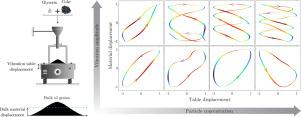Vibration-induced dynamics of granular materials in the vibro-compaction of carbon anodes
IF 4.6
2区 工程技术
Q2 ENGINEERING, CHEMICAL
引用次数: 0
Abstract
Vibro-compaction is a key stage in carbon anode production for aluminum manufacturing, where vertical vibration is used to rearrange particles, increase density, and enhance homogeneity. To simulate this process, we experimentally investigate the flow dynamics of representative dry and wet granular materials in a transparent container subjected to vertical vibration. Mixtures of calcined petroleum coke particles and glycerin simulate the behavior of anode paste. Using ultra-high-speed imaging, we analyze the effects of particle size, concentration, and vibration amplitude on flowability, characterized by bulk average height, angle of repose, frequency ratio, and phase lag. Our findings reveal a non-monotonic effect of particle concentration on the average height and angle of repose, with a peak at 85% concentration. In addition, increasing particle concentration decreases energy transfer efficiency between the vibration table and the material, resulting in complex subharmonic responses with significant deviations from sinusoidal behavior, particularly at higher vibration amplitudes. These subharmonic responses are visualized as so-called multi-loop Lissajous patterns, which describe the motion of the bulk material relative to the vibration table. Our findings enhance understanding of vibro-compaction and have implications for other vibration-based industrial processes, including pharmaceuticals, food processing, sediment transport, and powder metallurgy.

碳阳极振冲压实过程中颗粒材料的振动诱导动力学
振冲压实是铝制造碳阳极生产的关键阶段,其中垂直振动用于重新排列颗粒,增加密度,增强均匀性。为了模拟这一过程,我们实验研究了具有代表性的干湿颗粒材料在垂直振动作用下在透明容器中的流动动力学。煅烧的石油焦颗粒和甘油的混合物模拟阳极膏的行为。利用超高速成像技术,我们分析了粒径、浓度和振动幅值对流动性的影响,包括体积平均高度、休止角、频率比和相位滞后。我们的发现揭示了颗粒浓度对平均高度和休止角的非单调效应,并在浓度为85%时达到峰值。此外,颗粒浓度的增加降低了振动台和材料之间的能量传递效率,导致复杂的次谐波响应与正弦行为有明显的偏差,特别是在高振动幅值时。这些次谐波响应被可视化为所谓的多回路利萨约模式,它描述了大块材料相对于振动台的运动。我们的发现增强了对振冲压实的理解,并对其他基于振动的工业过程有启示,包括制药、食品加工、沉积物运输和粉末冶金。
本文章由计算机程序翻译,如有差异,请以英文原文为准。
求助全文
约1分钟内获得全文
求助全文
来源期刊

Powder Technology
工程技术-工程:化工
CiteScore
9.90
自引率
15.40%
发文量
1047
审稿时长
46 days
期刊介绍:
Powder Technology is an International Journal on the Science and Technology of Wet and Dry Particulate Systems. Powder Technology publishes papers on all aspects of the formation of particles and their characterisation and on the study of systems containing particulate solids. No limitation is imposed on the size of the particles, which may range from nanometre scale, as in pigments or aerosols, to that of mined or quarried materials. The following list of topics is not intended to be comprehensive, but rather to indicate typical subjects which fall within the scope of the journal's interests:
Formation and synthesis of particles by precipitation and other methods.
Modification of particles by agglomeration, coating, comminution and attrition.
Characterisation of the size, shape, surface area, pore structure and strength of particles and agglomerates (including the origins and effects of inter particle forces).
Packing, failure, flow and permeability of assemblies of particles.
Particle-particle interactions and suspension rheology.
Handling and processing operations such as slurry flow, fluidization, pneumatic conveying.
Interactions between particles and their environment, including delivery of particulate products to the body.
Applications of particle technology in production of pharmaceuticals, chemicals, foods, pigments, structural, and functional materials and in environmental and energy related matters.
For materials-oriented contributions we are looking for articles revealing the effect of particle/powder characteristics (size, morphology and composition, in that order) on material performance or functionality and, ideally, comparison to any industrial standard.
 求助内容:
求助内容: 应助结果提醒方式:
应助结果提醒方式:


